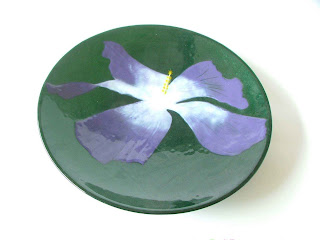The finished installation was successful. I had a call from the client saying he was thrilled by the result. He did not say "at last", but I did for him.
These photos show some of the windows created from the design of the door's fanlight.
The two above are the fourth and fifth rooms off the hall from the left to the right.
This is an image of the fanlight for the third room from the first.
A really nice part of the whole project was the request to design a window in keeping with the Arts Nouveau for the bathroom. This is a big window (approximately 1.4 metres by .9 metres). The object was to obscure the view inwards, but let a lot of light into the room. It is a very long corridor of a bathroom (Don't worry it is a dead end). This window is important in allowing natural daylight into the room.
I looked at a number of themes from the period. I used both books and my own images to come up with the modified water lilly theme shown below. The client agreed. And I began work. I enjoyed the process, although the leading is very complicated in places. I finished it in about a week and a half. So it was under priced, but more enjoyable than many other projects.
I am happy with the result and, more importantly, so is the client.






















